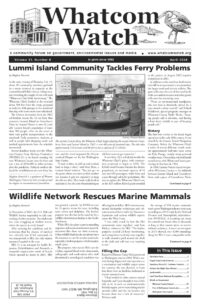Beaks and Bills
by Joe Meche
The vernal equinox occurs when the sun crosses towards the relevant hemisphere ending winter one more time. Even though it’s just another notch on the calendar it’s often cause for celebration amongst the winter-weary populace of northern climes. Spring officially arrives this year on Tuesday, March 19, and, for the first time in my 47 years here, I’m ready for it. Perhaps it has more to do with the fact that I haven’t spent as much time outdoors this year as I have in the past or maybe it’s just a by-product of the so-called Golden Years. Whatever the reason, I’ve had occasion to recall the lyrics of a favorite song by Don McLean from the early 70’s … “Winter Has Me in Its Grip.”
Winter has me in its grip
think I’ll take a summer trip
on a sunny sailing ship
where the shells lie in the sand.
Don’t get me wrong, the Pacific Northwest is still my home, but I might be dealing with the inner snowbird! If birds can migrate to climates that are more suitable for their needs, why can’t I? I’ve even planted the seed with Cindy and I’m sure we’ll discuss it a few times … until next winter that is.
To segue right into birds and spring migration, by the time you read this month’s column, spring migration will be underway for millions of birds, especially the shorebirds that I always look forward to seeing. In fact, we’re heading to the coast at the end of the February to celebrate our 28th anniversary and perhaps welcome the vanguard of shorebirds between Tokeland and Ocean Shores. Rest assured that coverage of that trip will come in the April issue of Whatcom Watch and I’ll look forward to sharing the experience with you.
Of all the species that migrate northward in spring, the shorebirds tend to be among my favorites. Large flocks of snow geese and sandhill cranes moving as one create some of nature’s greatest spectacles. The sounds alone are memorable as is their combined energy to reach their traditional nesting grounds. Many of our passerine species … the smaller, perching birds … migrate at night so we miss seeing them, unless you’re a radar technician. The shorebirds are different, however, and the reasons are visually obvious.
They’re primarily daytime migrants, so they provide a veritable feast for the eyes. They move up and down the coast with such predictability that festivals celebrate their passage from Mexico to Canada and as far north as Alaska. They are instinctively driven to nest and raise the young of the year and we get to see them in their annual passage. Their preferred habitats during migration are open beaches and estuaries where they stop to rest and refuel in their long journeys from as far away as Central and South America.
One of the beautiful things about shorebirds, especially during migration, is the frequent mix of species. While the old adage about birds of a feather sticking together holds true to some extent, shorebirds of different feathers can be found in similar habitats. On Bottle Beach last spring, I marveled at the mix of dowitchers, dunlin, semi-palmated plovers, and red knots sharing the beach with least and western sandpipers. This beach is on the road to Westport and is one of Washington’s premier locations offering opportunities to observe thousands of shorebirds at high tide during spring migration.
The varied areas around Grays Harbor, including Bowerman Basin and the beaches at Ocean Shores, are often touted to witness more than a million shorebirds during the spring migration. The basin is part of the Grays Harbor National Wildlife Refuge and is one of the four most important estuaries in North America for migrating shorebirds. On one particular three-day visit in the not so distant past, I conservatively estimated that I had observed 1.5 million birds. On the open beaches, the smaller shorebirds blend in well with larger species like marbled godwits and whimbrels, providing classic examples of the wide range of size differences. It’s like viewing your best field guide in real time, with a soundtrack of ocean surf for good measure.
Another appealing aspect to bird watchers, though not so much for the shorebirds, is the reliable sightings of peregrine falcons and merlins as they swoop into the flocks to capture a meal to help with their own survival. When these two members of the falcon family appear, the shorebirds lift as one and go into their seemingly orchestrated movements to avoid capture. These movements are known as murmurations and are a delight to behold … often eliciting cries of delight from the human observers.
Though not as numerous as the birds that migrate along the outer coast, the numerous bays and estuaries of the Salish Sea like Drayton Harbor and Semiahmoo Bay offer prime viewing of spring shorebirds, beginning in March and lasting into April. Of course, the spectacle reverses itself in the fall, but let’s take one equinox at a time. While Punxsutawney Phil gets most of the press in February no matter his prediction, it’s the vernal equinox that signals the end of winter for me.
__________
Joe Meche is a past president of the North Cascades Audubon Society and was a member of the board of directors for 20 years. He has been watching birds for more than 60 years, and photographing birds and landscapes for more than 40 years.





























